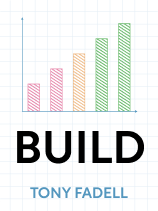

This article is an excerpt from the Shortform book guide to "Build" by Tony Fadell. Shortform has the world's best summaries and analyses of books you should be reading.
Like this article? Sign up for a free trial here.
What are the secrets to being successful in your career? How do you build a world-changing product-based business?
Entrepreneur Tony Fadell answers these questions and more in Build: An Unorthodox Guide to Making Things Worth Making. The book is part career encyclopedia and part memoir, detailing Fadell’s journey building the iPhone and starting Nest, a smart home device company.
Keep reading for an overview of this interesting and instructive book.
Build: An Unorthodox Guide to Making Things Worth Making
In our overview of Build: An Unorthodox Guide to Making Things Worth Making, we’ll discuss Fadell’s career trajectory. Then, we’ll share the lessons Fadell learned throughout his life, beginning with his tips on succeeding in every stage of your career. Last, we’ll share his advice on creating successful product-based businesses and building a great team.
Fadell’s Career: A Primer
Fadell’s lessons stem from his own career. In the early 1990s, Fadell’s passion for computers led him to a job at General Magic with the software industry’s leaders. Fadell was thrilled to be building Magic Link, a then-revolutionary handheld computing device that would let users connect to the internet, play games, and more.
However, Fadell soon realized that the Magic Link was bound to fail: It was directed toward the average American, who had no need or desire for it. He urged company leadership to redesign the product for businesspeople, who would benefit from a handheld computing device. Despite Fadell’s best efforts, company leadership refused, and the Magic Link failed to sell.
In 1995, Fadell quit General Magic and joined Philips—which was on board with Fadell’s idea—as CTO. As a first-time manager, Fadell struggled to manage people effectively and to convince business leadership to go along with his ideas.
Despite these challenges, Fadell oversaw the release of the Philips Velo and Nino—essentially business-focused smartphones. Although the products received critical acclaim, they didn’t sell well: Fadell’s team didn’t think through how to market them. Most people shopped at brick-and-mortar stores, which didn’t have a clear aisle in which to sell smartphones. An entirely new product also meant that stores didn’t know how to advertise or sell it.
In 1999, Fadell quit Philips to focus on his dream of building a handheld music device. That dream led to a job at Apple, where Fadell built several generations of the iPod and the iPhone and rose through the ranks to Senior Vice President.
Fadell After Apple
In 2010, Fadell quit Apple to travel the world with his family—and was consistently frustrated by old, inefficient thermostats. So that same year, Fadell (along with co-founder Matt Rogers) started Nest and became CEO. The company successfully released a smart thermostat and a smoke and carbon monoxide alarm. This success was thanks in part to Fadell’s insistence that brick-and-mortar stores market Nest products in a dedicated “Connected Home” aisle.
In 2014, Fadell sold Nest to Google, which wanted to expand into the smart home market. Fadell was thrilled at the opportunity to use Google’s massive resources to achieve Nest’s vision of creating a fully connected smart home. But the two companies struggled to integrate their cultures. Then, in 2015, Google restructured itself into Alphabet and gave Fadell one week’s notice that Nest would effectively turn into a non-Google company with no access to the resources Fadell had expected. Shortly after, Google told Fadell they were selling Nest—at which point Fadell quit. Google never sold Nest. But Fadell never looked back: Today, he spends his time on Build Collective, a venture capital firm.
How to Create a Successful Career
We’ll share Fadell’s tips on building a successful career at three stages of your professional life.
How to Start Your Career
The first step to creating a successful career, according to Fadell, is to figure out what you want to do. This doesn’t entail a specific salary or position; rather, ask yourself: What “mission,” or objective, inspires me to learn?
Second, Fadell recommends that you work for the right company. It should be working toward an objective similar to yours, have an original solution to an everyday problem experienced by the masses, and have the technical know-how to successfully create the product they’re promising.
Third, Fadell suggests that you pay attention to the broader goals of the company. Instead of focusing exclusively on your short-term goals, occasionally shift your perspective so you can assess how your job fits into the company’s long-term goals, how you can do your job better, and notice any potential landmines that could harm the company. To do so, talk to your colleagues.
Fourth, Fadell suggests that you know when to quit. At some point, you may realize that your company is not on track to fulfill the objective you share. If you see a major problem down the pipeline, point it out to your manager and offer a potential solution. If nobody does anything even after you’ve escalated the problem to the highest level you possibly can, leave, but make sure you don’t burn any bridges.
How to Be a Good Manager
Fadell argues that the key to managing people well is to find a balance between being hands-on and hanging back. Be hands-on in service of your mission, and push back if they’re not meeting your high expectations. But it’s not your job to nitpick about exactly how the team produces results. Decide together at the beginning of the project how the team will create the product and then check in regularly on their progress.
Fadell argues that managing decisions well depends on understanding what type of decision you’re making. Informed decisions rely primarily on hard data, so they’ll be relatively easy to make. But, instinctive decisions rely primarily on your own intuition. They may invite pushback from leadership.
To deal with this pushback, Fadell recommends that you tell a good story. Convince leadership that you have all the data you could possibly get, that you’re a good decision-maker who knows the customer well, that you’re mindful of the risks involved, and that this decision could be good for the company.
How to Be a Good CEO
Fadell explains that your job as CEO is to care about the company. Everybody in your company will now look to you for cues on how to behave, so pay attention to and demand high standards from every department.
Additionally, pay attention to developments outside the company. Don’t ignore innovative technologies that could transform your field.
One day, you may need to decide whether to sell your company. If so, Fadell recommends taking into account three major factors. First, ensure that your long-term goals complement each other. Second, know exactly what potential benefits this merger will provide. Third, evaluate how well your cultures mesh together.
How to Create a Product-Based Business
Now we’ll share Fadell’s advice on how to create a product-based business (a business that sells a tangible item).
Get Ready
Fadell asserts that being ready to start your own company requires that you have an incredible idea. A good idea proposes a solution to a real, tangible problem that people face consistently in their daily lives, and it has a clear why, or reason, for existing. Moreover, it’s something you can’t stop thinking about. If you’re going to commit years of your life to an idea, do research. What exactly are you getting yourself into? What issues might you face, and how might you get around those? If, after at least a month, you’re still excited by the idea, that’s a great sign that you should pursue it.
Additionally, Fadell argues that you must have the right experience and the right people. You have the right experience if you’ve worked at a startup and learned how to effectively hire people you need when you need them. You should have also worked at a large organization so you have some understanding of the issues, such as corporate drama, that large organizations face. You have the right people if you have an experienced, trustworthy mentor and a cofounder who can support you. You should also have a clear list of five amazing people you can hire—most of whom have robust networks and could hire even more amazing people. (We’ll discuss how to hire the right people later on.)
Discover Your Story
Once you have a good idea for a product, the experience to start a company, and the right people with which to build them, how do you start building the product? The most crucial step, Fadell argues, is to discover your story. In other words, you must figure out who wants your product and why, design every conceivable aspect of your product around that story, and test to ensure that story works.
Fadell explains that thinking through the whole story with your team (especially marketing) is essential because it drives both what you build and how you sell it—to investors and later to consumers. Many companies focus too much on the product itself because that’s what they think they’re selling; but in reality, a company sells an experience with a product—from how the customer installs it to the customer service they encounter if they run into trouble. Thinking through every aspect of that story will help you build and provide the best possible experience.
To tell an effective story, include three elements. First, remind people of the annoyance you’re solving so that they can get excited about the solution. Second, provide both logical and emotional reasons that your solution is the best possible choice. Third, simplify technical concepts so that your customers can easily grasp them and relate them to others. Try using analogies. If you struggle to determine your story, try writing a press release to clarify what you want your product to do and why it matters.
Release and Evolve the Product
The next step is to release the product. Fadell asserts that what you focus on in each release will depend on which product generation you’re working on.
The First Generation
Fadell asserts that your first-generation product must be “disruptive”—it must represent some sort of fundamental shift in how people normally do things. You may need to disrupt multiple elements of the customer experience; Nest disrupted both the thermostat (by making it smart) and how it was sold (by selling it directly to consumers). But don’t disrupt so many elements that your product isn’t immediately understandable.
To create a disruptive product, Fadell recommends that you work within clear limitations. Keep your team and budget small; the larger these become, the more likely you’ll waste time and money building unnecessary features. Additionally, set a clear timeline: It should take between nine and 18 months to ship your first product. To stick to that, create several internal deadlines. Each team should have recurring deadlines to ensure that they’re producing what they need to; there should also be regular project updates to ensure that everyone is on the same page. Finally, set a deadline for completing the product. If, when you reach that point, your product does almost everything you wrote in your press release, it’s ready to launch.
If your launch fails, figure out why. Examine the data to determine whether your intuition was flawed or if something external harmed your launch. Once you know why it failed, apply these lessons to your next launch—whether it’s a new version of this product or a new project entirely.
The Second Generation
When creating your second-generation product, don’t focus on disruption. Instead, improve upon the first generation without drastically changing the features that your customers have grown accustomed to. Now that you have real data from actual customers, making these improvements will rely more on this data than your opinion.
Additionally, consider the timing. Fadell recommends that you release updates to your products on a predictable schedule; that way, your customers will know when to expect new products, and your team will have clear deadlines to work toward. He recommends releasing one to three smaller updates and one large launch each year.
The Third Generation
By the third-generation product launch, focus on making money. Fadell states that your first-generation product likely won’t make you money, as most customers are generally wary of new technology. Your second-generation product should allow you to recoup your investments; by this point, you should have fixed the issues in the first generation and made a better product that works well for your customers. The third-generation product is when you focus on profitability so that you can keep the business going.
Handling Problems
No matter how well your launches go, you’ll likely face problems in your business. Fadell recommends strategies for three common ones.
Lack of Funds
If you lack funds for your business, you’ll need to find investors. To do so, Fadell first recommends that you have a clear plan regarding how much money you desire and what specifically you’ll use it for. However, you should have enough money to last for a few months since that’s how long finding the right investors will take. Second, Fadell suggests that you vet your investors carefully since you can’t fire an investor even if they’re bad. Pay attention to how well they treat you when you’re pitching them. If they’re disrespectful, want too much (more than 22%), or have a poor reputation among other startups, look for someone else.
Lack of Work-Life Balance
Another problem you may face when building a startup is a lack of work-life balance. Fadell asserts that if you’re starting a business, you’ll likely spend most of your time at work; however, it’s essential that you carve out some time for yourself so that you’re able to lead effectively. Get adequate sleep, nutrition, and exercise. Devote a few weekly blocks in your schedule for reflection so that you can give your brain an occasional break from work. If you’re overwhelmed with administrative tasks, hire an assistant so that you can focus on leading your team effectively. Finally, once the business is up and running, take vacations—and train yourself to let other people on your team handle the business.
Catastrophes
Another problem you may face when building a startup is some form of “crisis” or catastrophe. When you encounter a catastrophe, your first priority is to fix the problem. As a leader, you should dive into the everyday work your team does so that you can figure out with them how to fix it. You must also communicate effectively with your customers, apologizing if necessary. Only once you fix the problem should you examine why it happened and adjust your processes to ensure that something similar doesn’t occur again.
Then, Fadell recommends that you memorialize what happened. The narrative of how you successfully faced and fought through a catastrophe is important to your company; in the future, it will remind your employees that you can fight through another catastrophe because you’ve done it before.
How to Create the Right Team
In this section, we’ll first discuss how to hire people effectively. Then, we’ll share how to keep those people engaged at the company. Finally, we’ll discuss the four types of people you need on your team.
How to Hire the Right People
The first key to building an amazing team, Fadell explains, is to hire the right people. This should be your company’s biggest priority in the growth stage, as the people will make or break your company. To do it well, Fadell recommends that you develop a hiring structure that helps you decide whether the candidate will work well in the company by letting the candidate’s internal customers (ICs) make hiring decisions. As discussed earlier, everybody in a company has ICs—the people with whom they share deliverables. ICs should vet candidates so that they can ensure they’ll work well together.
How to Keep People Engaged
Fadell suggests two strategies for keeping the candidates you hire engaged throughout their time with your company: Handle transitions well, and prioritize benefits over perks.
Fadell argues that handling transitions well is essential to maintaining your company culture—the intangible elements that your employees value—and thus keeping your employees happy. As your business grows, you’ll face “breakpoints”—transitions in sizes that will require you to change how your company functions. As your company adds more employees, you’ll need to refine job descriptions, hierarchical structures, and communication processes to ensure that everyone stays in the loop and your company runs smoothly.
Fadell explains that you must prepare for these transitions, which inevitably cause big changes in employees’ roles and the company. Otherwise, you risk losing the culture that ties employees to your company—and thus the employees themselves. To do that, ensure that the culture that grew organically in the early stages of your company remains even as you grow larger. Prior to each transition, ask everybody to write down what they love about the company and exactly how they do things. Then, create systems to keep those things: Teach new employees what matters and how to follow old processes. As long as they’re written down, your company can maintain its culture—even as people leave.
Additionally, Fadell urges you to prioritize benefits over perks. Benefits are non-wage compensation, such as medical insurance; perks are fun bonuses, such as massages. Fadell warns that giving employees perks is dangerous: When people constantly get gifts, they don’t value the gift as much—but they still get upset if someone takes that gift away. So save your limited funds for benefits, which people value more.
Who You Need on Your Team
Fadell explains that you’ll need four types of people on your team.
Great Product Managers
A great product manager understands what the customer wants, communicates those desires to the team building the product, and later translates them into a marketing message to share with potential customers.
The Right Salespeople
Fadell suggests that you find salespeople willing to work outside of the traditional commission model. If your salespeople’s salaries depend only on whether the customer buys the product, they’re incentivized to sell at all costs. As such, they may treat the customer poorly—perhaps by misleading them about product features. Instead, implement a vested commission strategy. Incentivize the salespeople to treat potential customers well by giving them part of the commission when they sell, and the full commission the longer the customer stays with the company.
A Good Lawyer
To run any business, you must make legal decisions. At some point, it will be more cost-effective to hire your own lawyers instead of continuously outsourcing legal issues. Fadell recommends hiring a lawyer familiar with your business’s core competencies. A generalist won’t be able to advise you effectively without hiring other specialist lawyers and will also lack the legal expertise to advise those specialists effectively. So you’ll spend more money to get worse advice.
Fadell also cautions against blindly following your lawyer’s advice. Success often requires taking risks. A good lawyer will inform you of the potential legal consequences of those risks; a great one will help you find a better workaround to accomplish your goals. But ultimately, only you can decide what’s worth the risk.
An Amazing Board
Fadell writes that once you’re CEO, you’ll also need to create a good board: These are the people you’ll turn to for advice and the ones who can fire you if you do poorly.
Creating a good board requires that you include four types of people: a master networker who can introduce you to people who can help your business; investors, ideally those who are compassionate about the grind of building a company and not exclusively focused on their potential returns; an operations person—someone who’s built a company before and whose brain you can pick; and finally, a chairperson—someone who facilitates the board meetings, addresses any bad blood between board members, and supports your vision with the board.

———End of Preview———
Like what you just read? Read the rest of the world's best book summary and analysis of Tony Fadell's "Build" at Shortform.
Here's what you'll find in our full Build summary:
- Entrepreneur Tony Fadell's memoir, from the iPhone to Nest
- Advice for succeeding in every stage of your career, from beginners to CEOs
- Tips for building a product-based business and a great team






